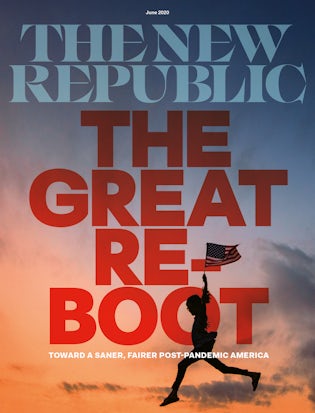
Is Email the Future of Journalism?
With the industry in free fall, new models are emerging.
by Alex Shephard
Last year was an extinction-level event in journalism. More than 3,000 jobs were lost in an industry that was already in rough shape. There were layoffs in every type of news organization: At BuzzFeed, The Atlanta Journal-Constitution,
Sports Illustrated, and countless other newsrooms. And thanks to the coronavirus lockdown, this year is shaping up to be even worse.
Digital and traditional media outlets have laid off thousands of workers. Last week alone saw drastic cuts at Vice, Quartz, and The Atlantic. Local news has been hit particularly hard; alt-weeklies and small and midsize papers have been decimated. The union representing The Cleveland Plain-Dealer had nearly 350 members two decades ago; today it has 14.
No one is immune. Old stalwarts and new startups alike are struggling. The Atlantic gained nearly 100,000 subscribers since March, but without its lucrative events business it nevertheless shed nearly a fifth of its workforce. Some properties, like Vox, have furloughed large portions of their staff. Many of the thousands of journalism jobs that have been lost will not be coming back any time soon, if ever. A wave of seed capital offset some of the damage of the 2008 recession, but few investors are keen on journalism now.
Journalism’s advertising model is all but dead, strangled by Google and Facebook. Many outlets, including The Atlantic, are increasingly relying on subscriptions for revenues, alongside a host of sidelines, including podcasts and events. But these strategies may not be enough, even in rosier economic circumstances. A number of large news organizations have begun lobbying Congress for bailouts of struggling, debt-ridden newspapers. And on Tuesday, the News Guild launched its #SaveTheNews campaign, aimed at immediate relief and long-term stability (and ensuring that private equity giants don’t end up hoovering up any public money).
But there is growing hunger for new models. Substack, a platform for paid newsletter subscriptions, is one such approach. In two and a half years, it has shown that it can provide a good living to individual journalists. As the media industry rapidly contracts, Substack has grown. Now the company is testing whether its model can work on a larger scale.
In a blog post published on the company’s website earlier this week, Substack founder Hamish McKenzie made the case that there “are early signs that we are witnessing the emergence of a new media economy.” Some Substack writers, he noted, were bringing in hundreds of thousands of dollars a year. The new model, he said, had spawned “a rapidly growing middle class, with writers and podcasters netting incomes that range from pocket money to high five figures.”
On the phone, McKenzie was a bit more cautious. “Substack provides an avenue for a new generation of publications,” he told me. “It’s not going to be the only path. Hopefully it’s an alternative path. It’s a model that works.” In this newsletter model, a subscription is often higher than a magazine subscription. I just subscribed to Ryan O’Hanlon’s excellent soccer newsletter for the cost of a print subscription to Bloomberg Businessweek.
The appeal for individual journalists is that a relatively low number of paid subscribers can provide a decent living; and those who enjoy high subscription rates are more than merely comfortable. For corporations, the model is less proven. “There are some publications, even of the stature and historical success of The Atlantic, that will struggle to cross over into a new realm,” McKenzie told me. “If you have to carry around a bunch of the legacy from previous generations of how magazines and newspapers were published, it’s like starting the race with a penalty.” Substack, in other words, is best positioned for new, small, and nimble publications, not bloated ones with sizable overheads.
Substack works well when individual writers with existing followings—often built up at more traditional outlets—take their audience with them. Emily Atkin, who left The New Republic to start HEATED, a climate newsletter, is in some ways the prototypical Substack newsletter writer and has built a hugely successful following in a manner of months. For writers who are skilled at self-promotion, have large existing followings, and are relatively self-sufficient (i.e., do not need a ton of money to do their reporting), Substack makes a lot of sense.
There have been recent experiments in building organizations that more closely resemble newsrooms. McKenzie described The Dispatch as a smaller, “center-right Atlantic”; founded by former National Review editor Jonah Goldberg and former Weekly Standard editor in chief Stephen F. Hayes, it raised millions of dollars in venture capital before launching last fall. McKenzie also pointed to The Discourse, a progressive blog founded by former staffers of Splinter. These are publications that are structured like the editorial side of blogs and magazines, with multiple writers and editors working on the project. Substack, meanwhile, provides much of the support one would typically get from the business and product divisions of a newspaper or magazine.
Whether this model would work for larger newsrooms is an open question. While a number of Substack writers make good money, it’s difficult to imagine how a newsroom could be supported by email alone. However, Ben Thompson’s Stratechery, which Substack’s founders cite as their inspiration, makes millions of dollars a year, suggesting that it is theoretically possible. And in seven months, The Dispatch is bringing in $1.4 million a year.
Substack’s early successes are based around topics, both general and niche: climate change, money in politics, sports. But there isn’t anything that looks like the area of journalism that is hurting the most: local news.
Substack represents an “unbundling” of news, the way that Netflix and other streaming services represent an unbundling of cable television’s hundreds of channels. Usually when you subscribe to a paper, you get some stuff you like and some stuff you don’t (you read the comics but maybe not the sports section), by some writers you like and some you don’t (I read Jamelle Bouie but not Thomas Friedman). But what if someone with 1,000 paid subscribers writing about sports in Columbus, Ohio, partners with another person with a decent following writing about the arts? Before you know it, you’ve reinvented the newspaper, sort of. “What can happen ultimately is that these things stop being isolated islands and start federating, hopefully among themselves, to create new bundles that service their communities and can be sliced and diced in different ways,” McKenzie told me. “Perhaps people can have new experiences that more deeply serve their needs, even if they live in communities that are traditionally poorly served.”
For now, Substack’s greatest asset is that it lies outside of Facebook and Google’s control (even if the latter does have a hold on email). In the meantime, Substack is trying to create an alternative, one that is “doing right by writers—and that means not screwing them.”